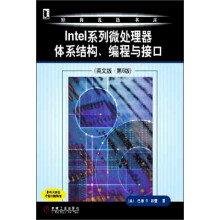INTRODUCTION TO THE MICROPROCESSOR AND COMPUTER Introduction/Chapter Objectives
1-1 A Historical Background
1-2 The Microprocessor-Based Personal Computer System
1-3 Number Systems
1-4 Computer Data Formats
1-5 Summary
1-6 Questions and Problems
THE MICROPROCESSOR AND ITS ARCHITECTURE Introduction/Chapter Objectives
2-1 Internal Microprocessor Architecture
2-2 Real Mode Memory Addressing
2-3 Introduction to Protected Mode Memory Addressing
2-4 Memory Paging
2-5 Summary
2-6 Questions and Problems
ADDRESSING MODES Introduction/Chapter Objectives
3-1 Data-Addressing Modes
3-2 Program Memory-Addressing Modes
3-3 Stack Memory-Addressing Modes
3-4 Summary
3-5 Questions and Problems
DATA MOVEMENT INSTRUCTIONS
Introduction/Chapter Objectives
4-1 MOV Revisited
4-2 PUSH/POP
4-3 Load-Effective Address
4-4 String
Data Transfers
4-5 Miscellaneous Data Transfer Instructions
4-6 Segment Override Prefix
4-7 Assembler Detail
4-8 Summary
4-9 Questions and Problems
ARITHMETIC AND LOGIC INSTRUCTIONS
Introduction/Chapter Objectives
5-1 Addition, Subtraction, and Comparison
5-2 Multiplication and Division
5-3 BCD and ASCII Arithmetic
5-4 Basic Logic Instructions
5-5 Shift and Rotate
5-6 String Comparisons
5-7 Summary
5-8 Questions and Problems
PROGRAM CONTROL INSTRUCTIONS
Introduction/Chapter Objectives
6-1 The Jump Group
6-2 Controlling the Flow of an Assembly Language Program
6-3 Procedures
6-4 Introduction to Interrupts
6-5 Machine Control and Miscella-neous Instructions
6-6 Summary
6-7 Questions and Problems
PROGRAMMING THE MICROPROCESSOR
Introduction/Chapter Objectives
7-1 Modular Programming
7-2 Using the Keyboard and Video Display
7-3 Data Conversions
7-4 Disk Files
7-5 Example Programs
7-6 Interrupt Hooks
7-7 Summary
7-8 Questions and Problems
USING ASSEMBLY LANGUAGE WITH C/C++ Introduction/Chapter Objectives
8-1 Using Assembly Language with C/C++ for 16-Bit Applications
8-2 Using Assembly Language with C/C++ for 32-Bit Applications
8-3 Separate Assembly Objects
8-4 Summary
8-5 Questions and Problems
8086/8088 HARDWARE SPECIFICATIONS
Introduction/Chapter Objectives
9-1 Pin-Outs and the Pin Functions
9-2 Clock Generator (8284A)
9-3 Bus Buffering and Latching
9-4 Bus Timing
9-5 READY and the Wait State
9-6 Minimum Mode Versus Maximum Mode
9-7 Summary
9-8 Questions and Problems
MEMORY INTERFACE
Introduction/Chapter Objectives
10-1 Memory Devices
……
BASIC I/O INTERFACE Introduction/Chapter Objectives
INTERRUPTS
Introduction/Chapter Objectives
DIRECT MEMORY ACCESS AND DMA-CONTROLLED I/O
Introduction/Chapter Objectives
THE ARITHMETIC COPROCESSOR AND MMX TECHNOLOGY
Introduction/Chapter Objectives
BUS INTERFACE
Introduction/Chapter Objectives
THE 80186, 80188, AND 80286 MICROPROCESSORS
Introduction/Chapter Objectives
THE 80386 AND 80486 MICROPROCESSORS
Introduction/Chapter Objectives
THE PENTIUM AND PENTIUM PRO MICROPROCESSORS
Introduction/Chapter Objectives
THE PENTIUM II, PENTIUM III, AND PENTIUM 4 MICROPROCESSORS
Introduction/Chapter Objectives
APPENDIXES
INDEX





 缺书网
缺书网 扫码进群
扫码进群